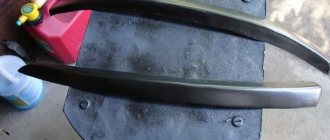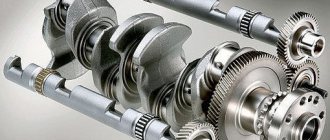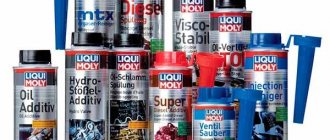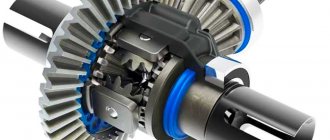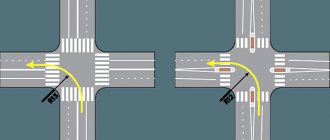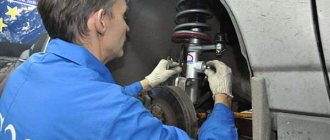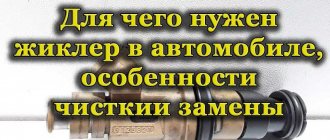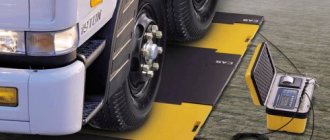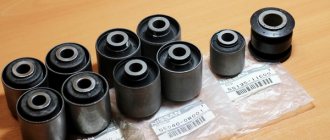Sometimes in a car there is a need to connect parts together not rigidly, using threaded, press or welding fits, but with a certain degree of freedom. In such cases, the connections are called hinged. Hinges can have different designs, depending on the required properties. In particular, with programmed elasticity in all directions of movement of the component parts.
To solve the tasks, silent blocks are used. Where they are installed, what types they are and what their disadvantages are, we will consider below.
Why are silent blocks needed?
Rubber-metal hinges (RMH) are commonly called silent blocks. This name will remind many of you of English lessons at school, when the teacher called the class to order using the word “Silence,” that is, silence.
This most accurately defines the essence of the RMS, its ability to elastically and silently transmit force. For this purpose, rubber or another similar material, for example polyurethane, is used in the hinge.
Where are they installed in the car?
Most often, silent blocks are used in car suspensions. This is where their basic properties are important:
- the ability to twist without collapsing friction between the component parts;
- quiet operation;
- the presence of a relatively large stroke for rotation with a minimum for all other displacements;
- a significant but gradual increase in resistance force when trying to bend the hinge in an undesirable direction;
- long service life provided that high-quality materials are used and normal operation is performed.
Typical applications are:
- hinges for attaching suspension arms to the body or subframes;
- shock absorber installation points;
- anti-roll bars;
- tips of jet rods.
In addition, silent blocks can be used at the mounting points of transmission units. This is done in order to minimize the transmission of vibrations and noise to the body, generally increase comfort in the car and dampen sharp, destructive impacts.
Summarize
- Silent blocks are located not only on the suspension arms, but also on the steering knuckles, stabilizer struts, etc.
- This is a hinge; it can have one bushing inside, or two – inside and outside. According to the type of pressing, there are internal and external.
- They come with a solid rubber insert or with cut out fragments in it.
- Polyurethane fillers are better than rubber fillers.
- To check the rubber-metal hinge, a visual inspection is sufficient. To accurately diagnose silent blocks, we use the “staggering” method. But in any case, if they have cracks, then they need to be replaced.
How the hinge works
The RMS consists of two metal bushings, between which there is an elastic element made of elastic rubber or polyurethane.
In fact, it is an elastically deformable bushing clamped between the clips, but there is one fundamental difference - the rubber of the silent block is glued or vulcanized to the metal of the clips, that is, in a working silent block, displacement of the bushing relative to the metal is excluded.
Friction is eliminated, hence the longer service life of the joint than that of a sleeve simply clamped with metal. Although sometimes bushing assemblies are also called silent blocks, which is not entirely true, but is used in the description of assemblies.
When the hinge is twisted, the rubber is deformed, but if the unit is correctly calculated, its irreversible destruction does not occur. Typically, hinges work specifically for rotation between metal cages, but it also happens to be used for bending.
For example, often the rear silent blocks of the front suspension arms of budget cars have a vertically oriented axis. The normal mode here will be the bending of the hinge, and not rotation.
This is interesting: Why do you need an on-board computer in a car and how does it calculate fuel consumption?
The RMS, installed in the eyes and traverses of fastening transmission units, does not have a clear orientation towards a specific working movement; here it rather acts as an elastic gasket between the massive unit and the body or frame of the car.
Due to the calculated rigidity of the rubber, peak vibration and shock loads can be absorbed in all directions. The hinges in the mounting eyes of telescopic shock absorbers serve approximately the same way, although here there is still a predominant direction of deformation towards rotation.
What is a silent block?
The part is made in the form of a small cylinder consisting of three elements:
- the outer part is made of thin-walled steel and equipped with seating elements - shell and stiffeners;
- core – solid metal sleeve;
- the gap between the outer and inner elements is filled with an elastic composition - rubber or polyurethane.
Reference. Manufacturers began using polymer as a filler relatively recently; previously only natural technical rubber was used.
The operation of any silent block is based on the fact that the inner sleeve, compressed on all sides by the elastomer, should not rotate. The outer shell “sits” just as tightly; it does not rotate relative to the rubber insert. But if sufficient torsional force occurs, the steel bushings can move relative to each other - due to the elasticity of the filler.
Types of silent blocks
Depending on the design, materials used or purpose, silent blocks can be divided into various categories, which highlight their main feature for this case:
- rubber or polyurethane, when the main parameter is rigidity and durability with fixed weight and dimensions;
- rigid or floating, in the second case we are more likely dealing with a more complex hinge, which includes a rubber elastic element;
- working for bending or rotation, depending on the predominant nature of the relative movement of the cages;
- according to the number of clips - sometimes the hinges do not have one or both metal bushings, and the elastic element is fixed with glue or vulcanization directly to the suspension parts; replacement in this case requires special repair structures or is carried out as an aggregate, that is, assembled.
It would not be a big mistake to use the term in cases where the unit is not a classic silent block. In the end, it is more important to reflect the essence of the functions performed in the name than to be academically precise.
Repair specifics
Considering that silent blocks are considered consumable automotive parts and in most cases are of low cost, in case of wear or breakdown, it is recommended not to repair, but to completely replace them. At the same time, some models of silent blocks are collapsible and therefore remain repairable.
The most difficult operation when replacing silent blocks is pressing them into the mounting fasteners, which is performed using special tools. If they are, you can do the work yourself. Otherwise, to perform quality repairs, you should contact specialists.
Advantages and disadvantages
The main advantages arise from the purpose of rubber-metal hinges:
- maximum quiet and comfortable operation of the unit;
- no maintenance requirements;
- there is no need to use lubricant, which deteriorates and develops over time;
- simplicity and low cost of design;
- diagnostic clarity that does not require qualified personnel;
- easy replacement at the end of its service life;
- the ability to set properties by selecting the material of the elastic element.
RMS competitors include all kinds of ball and cylindrical joints, which do not have the disadvantages inherent in silent blocks:
- Excessive freedom of movement in the hinge, characteristic of the RMS, is not always useful;
- cheap materials quickly age and deteriorate;
- rubber bushings do not work well at too high and low temperatures;
- strength under load is strongly related to the rigidity of the unit, and attempts to implement a compromise lead to an increase in weight, dimensions and cost;
- operating angles and the ability for relative movement of the clips over a wide range are limited.
On cars where control accuracy is more important than comfort and low price of the suspension, RMS have limited use. They are often replaced with ball joints (BJ) during sports car tuning.
Reasons for failure and what breaks in the silent block
Basically, the service life of any car part is affected not only by its quality, but also by operating conditions. It happens that a high-quality silent block does not exhaust its service life in a car that constantly drives on bumpy roads.
In another case, the car is used mostly in the city, and the driver drives carefully and measuredly. In such situations, even a budget silent block can waste a decent resource.
The main failure of silent blocks is rupture or deformation of the rubber part, because it is a damper of the fulcrum. In some nodes it is subject to torsional forces. Breakage of the metal clip occurs very rarely. The main reason for this is a violation of the pressing procedure.
The rubber part wears out prematurely in the following cases:
- Violation of technology for replacing silent blocks. When the mounting bolts are tightened, the vehicle should be firmly on its wheels and not jacked up. Otherwise, the incorrectly tightened part will become twisted after the machine is lowered to the ground. Subsequently, the rubber will tear under additional load.
- Violation of the pressing process. If the part is installed offset, the load will not be distributed evenly during operation.
- Natural wear and tear. Some drivers pay attention to silent blocks only when a problem arises with them, often exceeding the recommended service life.
- Aggressive exposure to chemicals. This reason includes the reagents that are sprinkled on the road. Regular machine oil also easily destroys rubber.
Here are some signs you can use to determine that silent blocks need to be replaced:
- The car has driven almost 100,000 kilometers (if the road conditions were of poor quality, the replacement interval is reduced - after approximately 50-60 thousand);
- Backlash appears, the car becomes unstable and less comfortable to drive;
- The tire tread pattern wears unevenly (it should be taken into account that this may be a consequence of other faults, which are discussed in a separate article);
- The lever mounts are damaged.
By carrying out timely and high-quality car maintenance, the car owner will avoid unnecessary waste on repairing parts that have not yet reached their due date.
Basic faults
Almost all failures of silent blocks are associated with wear and aging of the elastic element:
- rubber and, to a lesser extent, polyurethane change their properties over time, which leads to the appearance of cracks and a decrease in elasticity;
- during intensive work, the elastic bushings heat up, the material quickly gets tired and collapses;
- rubber may be detached from the metal; both glue and vulcanization have a limited service life, the bushing begins to slide over the metal and wear out, and play appears in the hinge;
- a worn-out hinge ceases to elastically transmit force, knocks and squeaks appear;
- It is possible that the fit of the metal bushings on the axles and in the eyes may become loose.
Rapid mechanical damage cannot be ruled out, especially in the event of malfunctions of other suspension parts, when loads and movements exceed the permissible limits for the hinge. The rubber simply breaks and the unit stops working correctly.
Varieties or what types exist
Can be divided into several types:
- With two clips: outer and inner;
- One clip, always internal;
- With technological cavities in rubber;
- Mounting lugs instead of bolt holes. Most often they are not symmetrical, it is important not to mix them up.
- Rubber – with rubber filler between the bushings;
- Polyurethane;
- Floating.
I would like to note that rubber quickly loses its elastic properties under the influence of chemicals that are sprinkled on roads in winter. Temperature changes also have a bad effect on it; oil and any petroleum products reduce its elasticity. As a result, the rubber “dumbs” and breaks under load. This affects the ride comfort and handling of the car.
Polyurethane is free from such phenomena . It retains elasticity and performance properties longer. In practice, it has been verified that polyurethane silent blocks in levers “run” longer than their rubber counterparts. But if there is an engineering miscalculation in the suspension design, then they also quickly fail and require replacement.
A floating silent block is a kind of ball joint . The inner sleeve in the middle has the shape of a ball. It is enclosed in a plastic insert. The cavity in which the ball rotates is closed from the outside world by a seal. Grease is placed inside.
The design is almost the same as that of a ball joint. Only in a “floating” silent block does the ball rotate around its axis, more precisely the axis of the bushing, and in the support it has a greater degree of mobility. Often such hinges are located in the torque rods or steering knuckles of the rear suspension.
Pros and cons of floating silent blocks
Advantages:
- The lever has large rotation angles.
- The smooth running of such a rubber-metal hinge.
- Less susceptible to the negative effects of external factors.
Flaws:
- When the seal ruptures, the ball wears out quickly. As in a ball bearing, if the boot is damaged, the support fails faster. Play and knocking appear when hitting bumps.
- The durability of the “floating” silent block directly depends on the amount of lubricant inside . Unscrupulous manufacturers take advantage of this and do not supply enough for long-term use. But checking this when purchasing is problematic.
To Contents...
How to check silent blocks
There are two verification methods - visual and instrumental. The reason for them will be routine prevention during routine maintenance, a change in the behavior of the machine, or the appearance of extraneous sounds.
Most often, hinges are rejected if, upon inspection, cracks in the rubber bushing are found in them. Sometimes this is not a well-founded reason, although it must be admitted that if the rubber begins to crack, then it will not last long, even if there are no backlashes or tears yet. The rigidity and load capacity have already changed.
How to increase the service life of silent blocks
There is only one recipe - careful treatment of the suspension as a whole. You can't expect a passenger car to have the capabilities of a racing SUV. Strong impacts at maximum deflection angles tear the rubber, after which a chain reaction of destruction of the entire suspension begins.
But the service life can also be shortened as a result of improper replacement of parts. There are main principles for carrying out work on the installation of RMSH.
Replacement instructions
Sometimes it is possible to replace a hinge without removing the main part from the car, but usually the lever or rod must be removed.
The internal race of the RMSh, as a rule, is attached through the axle in the form of a regular bolt. Here the problem can only arise in corrosion of the threaded connection, which can be eliminated by one of the known methods - applying a penetrating composition, pressing or shock loads, in extreme cases, mechanically cutting the axle and replacing the fasteners.
This you need to know: How the power steering works and works
The outer race is pressed out of the eye through a spacer of suitable size or with a specialized puller.
The force must be applied exclusively to the metal, the rubber will simply tear. The tension in the connections is small, no problems arise. In special cases, heating is used to burn out the rubber, after which the bushing can be sawed off.
The new part is carefully pressed into the cleaned eye using the same mandrel with the same requirements.
When installed on a car, the fastener is tightened only after the unit has been loaded normally, otherwise the hinge will be pre-tightened and will quickly collapse during operation. Only floating structures or individual rubber bushings can self-install.
Right choice
The choice is made after diagnosing the malfunction or during a planned replacement. It is necessary to understand what role the part plays in the suspension. Its task is to dampen vibrations that inevitably arise due to unevenness on the road.
Vibrations during movement are transmitted to the suspension springs, where they are partially damped by shock absorbers. The vibration then spreads to the frame through the connecting nodes. It is partially damped by silent blocks due to the presence of a soft base between the bushings. Therefore, the quality of the base must be of a high level.
Advantages of polyurethane:
- The service life is increased by 5 times. This allows replacements to be made after long mileage intervals and the suspension to be loaded more aggressively.
- Increased thermal stability. Polyurethane tolerates temperature changes well. The material works just as well in cold weather as at high temperatures.
- Thanks to the dense structure of the material, vehicle handling is improved.
Rubber and polyurethane are equally popular. Drivers themselves choose what to focus on. With rubber spacers you can get increased riding comfort, but improved handling can only be achieved with polyurethane. But in the latter case, comfort decreases, which is especially felt by passengers.
When purchasing a part, it is better to consult a specialist in the store. The fact is that vibration isolators are difficult to distinguish from each other in appearance - they are almost similar. But their outer diameter is sometimes slightly different, which will cause installation difficulties.
DETAILS: Replacing silent blocks on a VAZ 2110 Photo instructions on how to change silent blocks on a VAZ 2110
